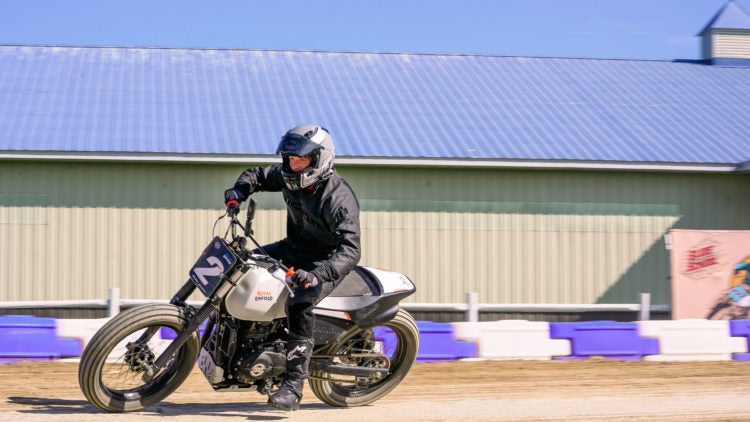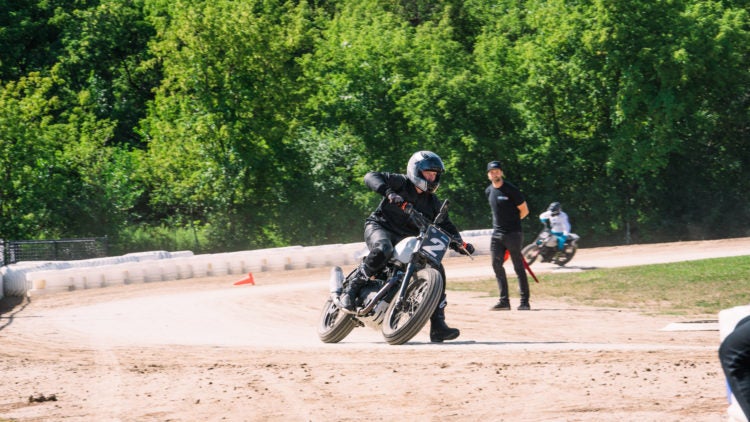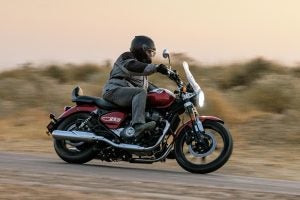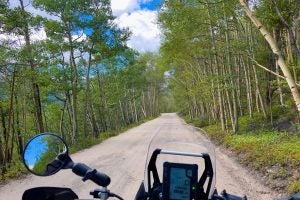
A mildly customized Royal Enfield Interceptor makes for a great flat tracker.
Every single category of motorcycles comes with its own style of riding and more often than not, a dedicated race series. Get enough riders together with similar bikes and it’s not long before someone says they’re the best, someone disagrees, and then rules for a race are drawn up. Another guarantee is that each style of riding and motorcycle demands its own set of skills to be fine-tuned. Whether that’s ADV, dirt bikes, street bikes, or any other kind of bike, you can’t ride one type as quickly using another’s style and method. It’s a truism I learned almost immediately attempting flat track riding for the first time at the Moto Anatomy Slide School on a lightly modified Royal Enfield Interceptor, earlier this year.
The night before the Slide School at Weedsport Speedway in New York, I was able to attend the American Flat Track Event and get a scaled-up sense of what I’d be in for. I’ve covered enough miles on my fair share of bikes and watched enough motorcycle races to know my first time on a flat-track bike wouldn’t measure up to what the pros were dishing out. Still, that didn’t stop that voice in the back of my head uttering the always-regrettable phrase “it doesn’t look too hard.” The truth is (as usual) the guys and gals slinging their bikes around the track make it look so damn easy because they’re just that good.

Slide School uses a much smaller track than the one the pros race on, but it’s fun nonetheless.
As a spectator, flat-track appears relatively straightforward. Ride around on a circle track as fast as you can, plant your inside foot on the ground in the turns, slide the rear, get on the throttle, and repeat. On the surface, it appears to have more in common with motocross riding, utilizing similar techniques. “That’s the first mistake everyone makes coming to flat track,” said Johnny Lewis, founder of Moto Anatomy and the day’s lead instructor. “You might be sticking a leg out and riding on dirt, but the way you ride flat track is more like riding a street bike.” Before even throwing a leg over the Royal Enfield Flat tracker, there was a classroom-style run down.
The bike, a modified 2020 Royal Enfield Interceptor 650, looks at home on a circle track, but admittedly has very little work done to it. Moto Anatomy only modified the seat, tail section, bolted on a set of flat track-grade tires and got rid of the front brakes since they never get used anyway. When asked if there was any other mechanical work, Lewis replied, “Nope. the only thing we would change is the suspension, but we even left that alone. It’s not the greatest and has a lot of give, but that’s good. When you’re learning to ride flat track, I want you to feel the mistakes you make through the suspension. Any unnecessary braking, throttle, weight transfer, you’re going to feel that more with the stock suspension. It’s a good learning tool.”

The gear for flat tracking is a mix of enduro and street for maximum mobility and protection.
When Lewis went over the proper flat track technique, that’s when the “more like street riding than motocross” came into focus. Heading into a turn, you dip the bike, extending your inside arm, and applying pressure to the tank with your outside knee. Dragging the foot is more akin to dragging a knee in that you use it as a ground sensor of sorts but, mainly it’s out there to help take the weight off the bike, rather than transferring weight forward like in motocross.
Planting the inside foot as you turn allows you to help rotate the bike into the turn, the only time you actually want the rear sliding. This, in combination with simultaneously feathering the rear brake and utilizing engine braking, puts the bike into the classic flat-track style corner entry slide (when done correctly). There’s no shifting to worry about on shorter courses and you never touch the front brakes, because, well, there are none. Once you’re mid-corner, it’s back on the throttle, but it’s not an on-off situation. It’s more like a dimmer switch, easing on the power as you search for grip. If you ever watch flat track racers get squirrely on corner exits, as dramatic and as awesome as it looks, that’s the slower way around the track. “And on smaller tracks, there’s no real straightaways to reset. If you blow a turn, it’ll take you two or three more turns before you can get back up to speed,” said Lewis.

Flat track riding demands some rewiring of some old habits, but it’s absolutely necessary to progress.
As a spectator, flat track racing is a rapid-fire event with racing so close any minor mistake can give the upper hand to your competitors. From the stands, or the couch, it looks fast and loose and its recent rise in popularity is completely understandable. It’s a true spectacle of skill and motorsport. On the bike, attempting flat track for the first time myself, I have a newfound respect for the pros who do it well and make it look so damn easy. To those in the know, the riders seemingly flying into each corner with reckless abandonment are actually in total control, seamlessly going through the motions braking, sliding, and rotating through a corner at highway speeds. Each corner entry and exit is calculated. Once you understand that, taking the next steps to progress and improve your own ability becomes that much easier. Is it still difficult to get it right as a complete novice? Yes. Is it rewarding when you do? Absolutely.







